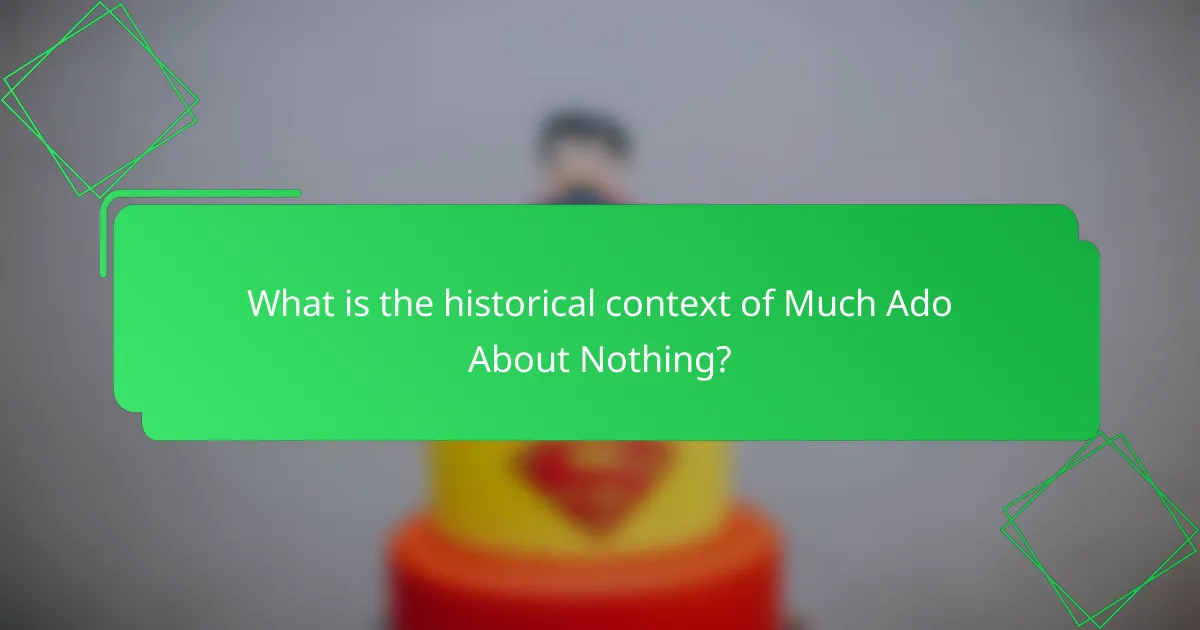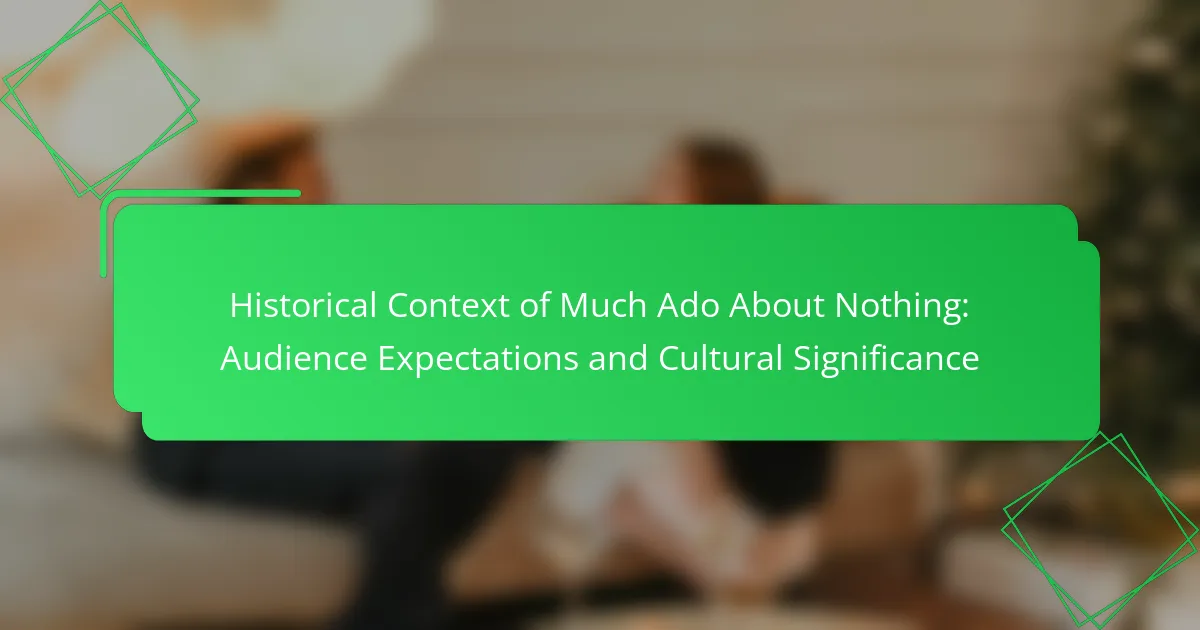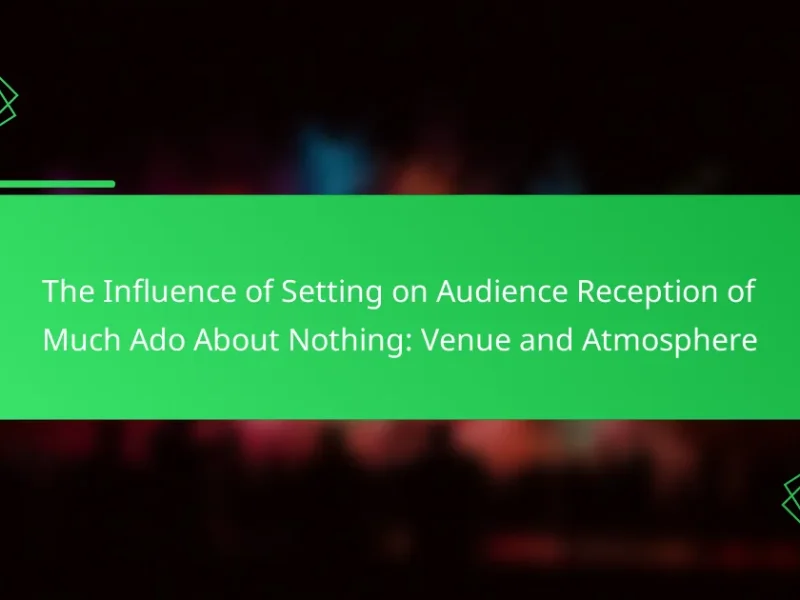
What is the historical context of Much Ado About Nothing?
Much Ado About Nothing was written by William Shakespeare around 1598. This period was marked by the flourishing of English drama. The play reflects societal norms and expectations of the Elizabethan era. Themes of honor, courtship, and deception were prevalent during this time. The audience expected witty dialogue and complex characters. Gender roles were significant, with women often portrayed as virtuous or deceptive. The play also showcases the importance of social status and reputation. Much Ado About Nothing engages with these cultural values, making it relevant to its original audience. The historical context enhances the understanding of its themes and characters.
How does the historical background influence audience expectations?
Historical background significantly influences audience expectations by shaping cultural norms and values. Audiences bring prior knowledge and experiences to their interpretations. For example, Elizabethan audiences had specific expectations regarding gender roles and social hierarchies. These expectations were influenced by the societal context of the time, including the rigid class structures and patriarchal norms. Consequently, when viewing “Much Ado About Nothing,” audiences anticipated specific behaviors from characters based on these historical norms. Additionally, historical events, such as the rise of the Renaissance, affected the themes of love and wit presented in the play. This context allowed audiences to engage with the text on multiple levels, influencing their emotional and intellectual responses. Thus, the historical background creates a framework that guides audience interpretations and expectations.
What social and political factors shaped the play’s themes?
Social and political factors that shaped the themes of “Much Ado About Nothing” include gender roles and class distinctions. The play reflects the Elizabethan era’s expectations of women, emphasizing chastity and obedience. Characters like Beatrice challenge these norms, showcasing the tension between societal expectations and individual desires. Additionally, the class system influences relationships and power dynamics within the play. The conflict between the nobility and lower classes highlights issues of honor and reputation. Historical context indicates that these factors were critical in shaping audience perceptions and responses to the themes presented.
How did contemporary events impact Shakespeare’s writing?
Contemporary events significantly influenced Shakespeare’s writing. The political climate of Elizabethan England shaped his themes and characters. The defeat of the Spanish Armada in 1588 fostered national pride, reflected in plays like “Henry V.” Social issues, such as class tensions and gender roles, were prevalent in his works. The plague outbreaks led to theater closures, prompting Shakespeare to write sonnets and narrative poems. The rise of humanism encouraged exploration of individualism in characters. Additionally, the monarchy’s influence affected censorship and content. Shakespeare’s engagement with these events made his plays relevant to his audience.
What cultural significance does Much Ado About Nothing hold?
Much Ado About Nothing holds significant cultural importance as a reflection of societal norms and gender roles in the Elizabethan era. The play explores themes of love, honor, and deception, which resonate with contemporary audiences. It also critiques the expectations placed on women and men in relationships. The character of Beatrice challenges traditional gender roles through her wit and independence. Additionally, the play’s comedic elements provide insight into the human condition and social dynamics. Its enduring popularity demonstrates its relevance across different cultures and time periods. The play has been adapted into various forms, showcasing its adaptability and cultural impact.
In what ways does the play reflect Elizabethan values and norms?
The play reflects Elizabethan values and norms through its portrayal of social hierarchy and gender roles. Characters are often defined by their social status, emphasizing the importance of class in Elizabethan society. For instance, the noble characters display traits of honor and loyalty, which were highly valued during this period.
Additionally, the play reinforces traditional gender expectations. Women are often depicted as obedient and chaste, aligning with societal norms of the time. The character of Hero embodies the idealized woman, demonstrating virtues such as fidelity and submission.
Moreover, the theme of marriage serves as a reflection of Elizabethan values. Marriages are often arranged for social and economic gain rather than love. This mirrors the societal expectation that marriage is a transaction rather than a romantic union.
The play also addresses the consequences of reputation and honor, which were crucial in Elizabethan society. Characters face social ostracism due to perceived dishonor, highlighting the community’s emphasis on public image and integrity.
Overall, “Much Ado About Nothing” encapsulates the values of the Elizabethan era through its character dynamics, themes of marriage, and societal expectations surrounding gender and honor.
How has the play’s interpretation evolved over time?
The interpretation of “Much Ado About Nothing” has evolved significantly over time. Initially, the play was performed primarily as a lighthearted comedy in the Elizabethan era. Audiences expected straightforward humor and romantic resolutions. In the 20th century, interpretations began to explore deeper themes such as gender roles and social commentary. Productions increasingly highlighted the complexities of love and deception. Modern adaptations often incorporate contemporary issues, reflecting current societal norms and values. For example, feminist readings have gained prominence, focusing on Beatrice’s character and her assertiveness. This evolution demonstrates the play’s adaptability and relevance across different historical contexts.

How did audience expectations shape the reception of Much Ado About Nothing?
Audience expectations significantly shaped the reception of Much Ado About Nothing. Audiences in the Elizabethan era anticipated a blend of comedy and romance. They expected clever dialogue and witty banter, which the play delivered through its central characters, Beatrice and Benedick. The use of mistaken identities and misunderstandings aligned with audience preferences for humor and intrigue. Furthermore, the themes of love and honor resonated with societal values of the time. The play’s comedic elements met audience desires for entertainment, contributing to its popularity. Historical records indicate that Much Ado About Nothing was well-received during its initial performances, reflecting these audience expectations.
What were the typical audience demographics during Shakespeare’s time?
The typical audience demographics during Shakespeare’s time included a diverse range of social classes. This audience comprised nobility, middle-class merchants, and commoners. The Globe Theatre, where many of Shakespeare’s plays were performed, attracted people from various backgrounds. Tickets varied in price, allowing access to both wealthy patrons and those of lower economic status. The presence of both genders was also notable, with women attending performances, although often in limited numbers. Historical records indicate that the audience often included young men and women, reflecting the play’s appeal across age groups. Overall, Shakespeare’s works resonated with a broad demographic, contributing to their enduring popularity.
How did class differences influence audience reactions?
Class differences significantly influenced audience reactions to “Much Ado About Nothing.” The play’s themes resonated differently across various social strata. Higher-class audiences often appreciated the wit and wordplay. They viewed the comedic elements as a reflection of their own social dynamics. In contrast, lower-class audiences might have focused more on the plot’s moral lessons. They related to the struggles of characters like Beatrice and Benedick. Historical accounts indicate that social class dictated seating arrangements in theaters. This segregation affected how individuals interpreted the humor and conflict within the play. Additionally, class disparities shaped expectations for character behavior and resolution. The upper class expected refined manners, while the lower class sought relatable authenticity. Thus, class differences created a varied landscape of audience reactions.
What role did gender play in audience expectations?
Gender significantly influenced audience expectations in the context of “Much Ado About Nothing.” Audiences anticipated specific behaviors and characteristics from male and female characters based on societal norms of the time. Male characters were often expected to display dominance and assertiveness. Female characters were expected to embody virtues of chastity and obedience. These gender roles shaped how audiences interpreted character interactions and plot developments. For instance, the comedic elements relied on the contrast between male bravado and female wit. Historical context reveals that Elizabethan society had strict gender expectations, which directly impacted how the play was received. The audience’s understanding of gender roles allowed for a deeper engagement with the themes of love and deception presented in the play.
What elements of the play appealed to contemporary audiences?
The elements of “Much Ado About Nothing” that appealed to contemporary audiences include its witty dialogue and complex characters. The play features sharp banter and clever wordplay, which entertained the audience. Additionally, the themes of love and deception resonate with viewers. The portrayal of strong female characters, like Beatrice, challenged societal norms. The comedic elements provided a lighthearted escape from everyday life. Furthermore, the social commentary on relationships sparked discussions among the audience. The setting in a familiar Italian locale added to its appeal. Overall, these elements combined to create a relatable and engaging experience for contemporary viewers.
How did humor and wit resonate with Shakespeare’s audience?
Humor and wit were central to Shakespeare’s appeal to his audience. They provided entertainment and relief from the serious themes of his plays. Shakespeare often used wordplay, puns, and clever dialogue to engage viewers. This style resonated particularly well with the Elizabethan audience, who appreciated verbal dexterity.
The comedic elements in his works, such as in “Much Ado About Nothing,” highlighted social norms and human folly. Audiences found humor relatable, as it reflected their own experiences and societal dynamics. Additionally, the use of humor often served to critique social hierarchies and relationships.
Shakespeare’s characters frequently employed wit to navigate complex situations, making them more accessible to the audience. The laughter generated by these interactions fostered a communal experience among viewers. This connection enhanced their overall enjoyment and engagement with the performance.
What themes of love and deception were particularly relevant?
Themes of love and deception in “Much Ado About Nothing” are critical to its narrative. Love is portrayed as both genuine and complex, often intertwined with misunderstandings. Deception is used as a plot device, highlighting the fragility of relationships. For instance, Claudio’s public shaming of Hero reflects societal expectations and the consequences of deception. The play illustrates how love can be manipulated through lies, as seen in Don John’s schemes. These themes resonate with the audience’s understanding of romance and trust, making them particularly relevant in the play’s historical context.

What are the lasting impacts of Much Ado About Nothing in modern culture?
Much Ado About Nothing has significantly influenced modern culture through its themes and characters. The play’s exploration of love, deception, and social expectations remains relevant today. Its witty dialogue and complex relationships have inspired countless adaptations in film and theater. For instance, the 1993 film adaptation by Kenneth Branagh brought the story to a new audience. Additionally, the character dynamics, particularly between Beatrice and Benedick, have set a standard for romantic comedy tropes. The play also critiques societal norms, prompting discussions on gender roles that continue in contemporary discourse. Its enduring popularity is evident in various pop culture references and modern retellings across different media.
How is the play adapted in contemporary performances?
Contemporary performances of the play are adapted to reflect modern themes and societal issues. Directors often reinterpret characters to resonate with today’s audiences. For instance, gender roles may be reexamined to address current discussions on feminism. Settings and costumes can also be updated to fit contemporary aesthetics. Additionally, language may be modernized while retaining the original plot. Some adaptations incorporate multimedia elements to enhance engagement. These changes aim to make the play more accessible and relevant. Such adaptations can lead to varied interpretations that challenge traditional views.
What modern themes can be drawn from the original text?
Modern themes drawn from “Much Ado About Nothing” include the complexities of love and relationships. The play explores misunderstandings and deception, reflecting contemporary issues in communication. Gender roles and societal expectations are also prominent, showcasing the challenges women face. Themes of honor and reputation remain relevant, as they influence personal and social dynamics today. Additionally, the importance of friendship and loyalty highlights human connections across time. These themes resonate with modern audiences, illustrating timeless human experiences.
How do adaptations reflect current societal issues?
Adaptations reflect current societal issues by reinterpreting themes and characters to resonate with contemporary audiences. They often address modern social concerns such as gender roles, class disparities, and racial dynamics. For example, adaptations of “Much Ado About Nothing” may highlight issues of consent and power dynamics in relationships. This relevance helps engage viewers who see their own experiences reflected in the narrative. Additionally, adaptations can incorporate current language and cultural references, making the story more accessible. Historical context is also reexamined to align with present-day values and beliefs. Overall, adaptations serve as a mirror to society, showcasing evolving norms and challenges.
What practical insights can we gain from studying Much Ado About Nothing?
Studying Much Ado About Nothing offers practical insights into social dynamics and communication. The play highlights the importance of misunderstandings in relationships. It showcases how gossip can distort truth and impact reputations. Additionally, the characters’ interactions reveal societal expectations regarding honor and fidelity. The comedic elements demonstrate the value of wit and humor in resolving conflicts. Moreover, the portrayal of gender roles reflects the societal norms of the Elizabethan era. The play also illustrates the significance of loyalty and friendship in overcoming adversity. These insights remain relevant in understanding contemporary social interactions and conflicts.
How can understanding historical context enhance our appreciation of the play?
Understanding historical context enhances our appreciation of the play by providing insights into the societal norms and values of the time. The Elizabethan era, when “Much Ado About Nothing” was written, had distinct views on gender roles, marriage, and honor. Recognizing these aspects allows audiences to grasp character motivations and plot developments more deeply. For instance, the expectation for women to be virtuous and submissive impacts characters like Hero. Additionally, the historical context of courtly love influences the play’s romantic dynamics. Awareness of these elements enriches the viewing experience and fosters a greater connection to the text.
What lessons can modern audiences learn from the themes presented?
Modern audiences can learn the importance of communication and misunderstandings from the themes in Much Ado About Nothing. The play illustrates how miscommunication can lead to conflict and resolution. Characters often jump to conclusions based on incomplete information. This reflects real-world situations where assumptions can create unnecessary drama. Additionally, the theme of honor and reputation emphasizes the impact of societal expectations. Audiences can recognize the relevance of personal integrity and social perception today. The exploration of love and relationships in the play shows the complexities of human emotions. This encourages viewers to reflect on their own relationships and societal norms.
The main entity of the article is “Much Ado About Nothing,” a play by William Shakespeare written around 1598. The article explores the historical context of the play, emphasizing the societal norms and expectations of the Elizabethan era, including themes of honor, courtship, and deception. It examines how these historical factors influenced audience expectations and shaped their interpretations, particularly regarding gender roles and class distinctions. Additionally, the article discusses the cultural significance of the play, its adaptation over time, and the lasting impacts on modern society, highlighting the relevance of its themes in contemporary discussions on relationships and social dynamics.


